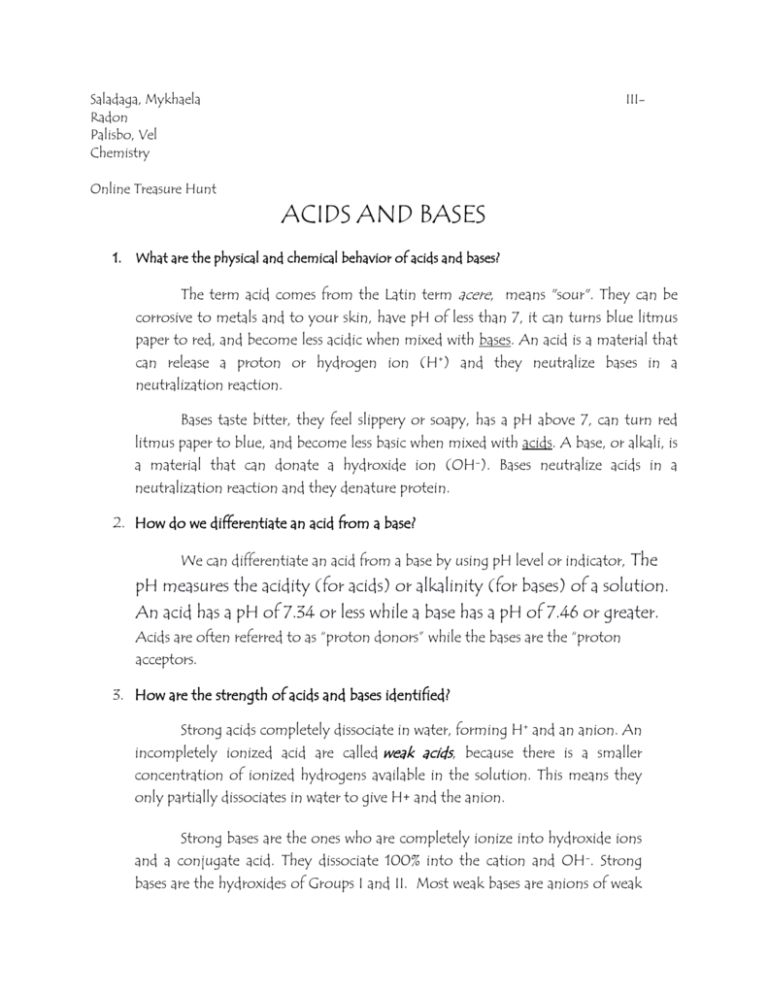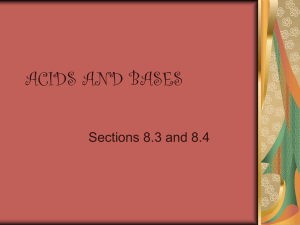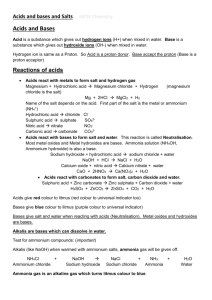Saladaga, Mykhaela III- Radon Palisbo, Vel Chemistry Online
advertisement

Saladaga, Mykhaela Radon Palisbo, Vel Chemistry III- Online Treasure Hunt ACIDS AND BASES 1. What are the physical and chemical behavior of acids and bases? The term acid comes from the Latin term acere, means "sour". They can be corrosive to metals and to your skin, have pH of less than 7, it can turns blue litmus paper to red, and become less acidic when mixed with bases. An acid is a material that can release a proton or hydrogen ion (H+) and they neutralize bases in a neutralization reaction. Bases taste bitter, they feel slippery or soapy, has a pH above 7, can turn red litmus paper to blue, and become less basic when mixed with acids. A base, or alkali, is a material that can donate a hydroxide ion (OH-). Bases neutralize acids in a neutralization reaction and they denature protein. 2. How do we differentiate an acid from a base? We can differentiate an acid from a base by using pH level or indicator, The pH measures the acidity (for acids) or alkalinity (for bases) of a solution. An acid has a pH of 7.34 or less while a base has a pH of 7.46 or greater. Acids are often referred to as “proton donors” while the bases are the “proton acceptors. 3. How are the strength of acids and bases identified? Strong acids completely dissociate in water, forming H+ and an anion. An incompletely ionized acid are called weak acids, because there is a smaller concentration of ionized hydrogens available in the solution. This means they only partially dissociates in water to give H+ and the anion. Strong bases are the ones who are completely ionize into hydroxide ions and a conjugate acid. They dissociate 100% into the cation and OH-. Strong bases are the hydroxides of Groups I and II. Most weak bases are anions of weak acids. Weak bases do not furnish OH- ions by dissociation. They react with water to furnish the OH- ions. 4. How are acids and bases quantified? By using pH scale, it is a measure of the acidity or basicity of a solution. It is defined as the cologarithm of the activity of dissolved hydrogen ions (H+). the pH indicator causes the color of the solution to change depending on the solution’s pH level. The pH scale is not an absolute scale; it is relative to a set of standard solutions whose pH is established by international agreement. 5. What are pH indicators? An acid-base indicator is a weak acid or a weak base. The undissociated form of the indicator is a different color than the iogenic form of the indicator. An Indicator does not change color from pure acid to pure alkaline at specific hydrogen ion concentration, but rather, color change occurs over a range of hydrogen ion concentrations. This range is termed the color change interval. It is expressed as a pH range. 6. What are common applications/uses of acids and bases? ACIDS Used in: BASES Used in: Sulfuric Acid Car Batteries sodium hydroxide Soaps Acetic Acid vinegar magnesium hydroxide Antacid Tartaric Acid Baking Aluminum hydroxide Deodorants Ascorbic VitaminC Sodium Dish carbonate Detergents Acid Nitric Acid Fertilizers Carbonic Acid Softdrinks Citric Acid Citrus Fruits Sodium hypochlorite Bleach









